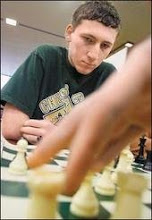Sorry everybody. I have the next game ready for video, but I have not been feeling well enough to actually record it. For now, I will post the game in pgn form (for some reason you can't embed files on Blogger) and you can save the text as a pgn and view it if you would like. Once I get feeling a bit better I will turn it into a video post for those of you that are lazy or don't have a pgn viewer. What is below is more or less what I will say in the video, so if you want a sneak preview of it then you can go through what is below.
[Event "Cedar Rapids Leatherjackets"]
[Site "Cedar Rapids"]
[Date "????.??.??"]
[Round "?"]
[White "Tyagi"]
[Black "Madison"]
[Result "0-1"]
[ECO "A40"]
[Annotator ",Jeremy"]
[PlyCount "36"]
{Annotated by Jeremy!} 1. d4 e6 2. c4 b6 3. Nc3 f5 4. g3 Bb7 5. Nf3 Nf6 6. Bg2
Be7 7. O-O O-O 8. b3 {This is where we leave my database, although I am sure ..
.d6 has been played before.} d6 9. Bb2 ({The main alternative is:} 9. d5 e5 {
The e6 square is where the entire game revolves.} 10. Ng5 Bc8 11. Ne6 Bxe6 {
Black has to be careful not to lose this exchange with the light squared
bishops off the board.} 12. dxe6 c6 {Will this pawn mean victory or defeat?})
9... Nbd7 $2 {Sometimes development is wrong.} (9... d5 {
Immediately was much stronger.}) 10. Nd2 $2 (10. Ng5 {Outright wins a pawn.}
Bxg2 11. Kxg2) 10... Bxg2 11. Kxg2 d5 {Now the fight is being taken to white.}
12. e3 {This light square complex is a lot weaker without the light squared
bishops on the board, which is why black was more than happy to trade them off.
The difference is that the light squared weakness in black's position are in
an area that cannot be exploited anytime soon. White's light square weaknesses
are right around the king, where several black pieces can immediately attack
them.} c6 {
Indirectly supports the attack by tightening the grip on the light squares.}
13. Nf3 {Eyeing e5, but this game is about light squares.} Bd6 {"Defends" the
e5 square, but more importantly is aiming at the pawns in front of the enemy
king.} 14. Qc2 {An attempt at fighting for e4, but this needed to be done
earlier with the Knight on d2, so that f3 and e4 could be tried.} Ne4 {
Now there is just not enough time for white to get in all of the moves they
want. Black has an advantage no matter how you slice it.} 15. Nd2 {
f3 is the obvious followup, so what should black do?} Qg5 {Trying to get the
knee-jerk f4 played, when there are more permanent weaknesses around the white
king. This also sets a most devious trap on f3.} 16. f3 (16. f4 Qg6 {The idea i
s to throw the h-pawn to break up the pawns in front of the white king. If
Rook support is needed on the h-file, Kf7 is perfectly safe to play followed
by doubling on the h-file.}) 16... Nxg3 {Black is completely won now. White's
only option for continuing the game is to move the f1 rook and just hope.} 17.
f4 (17. hxg3 Qxg3+ 18. Kh1 Qh2#) (17. Rfe1 Ne4+ 18. Kf1 Nxc3 19. Qxc3 Bxh2 {
With a winning edge for black.}) 17... Nxf1+ {
But that's just losing for black right?} 18. fxg5 Nxe3+ {Black has seen one
move more than white, and that is the cause of this win for black. Notice that
black did not really have a particularly clear plan until the exchange of
light squared bishops, when the plan of light squared play became simple to
find. These are the kinds of things to look for in your own games. Slight
differences can radically change the correct ideas.} 0-1
Thursday, April 15, 2010
Like Jeremy's Chess Adventures on facebook!
Subscribe to this Blog!



Custom Search



No comments:
Post a Comment